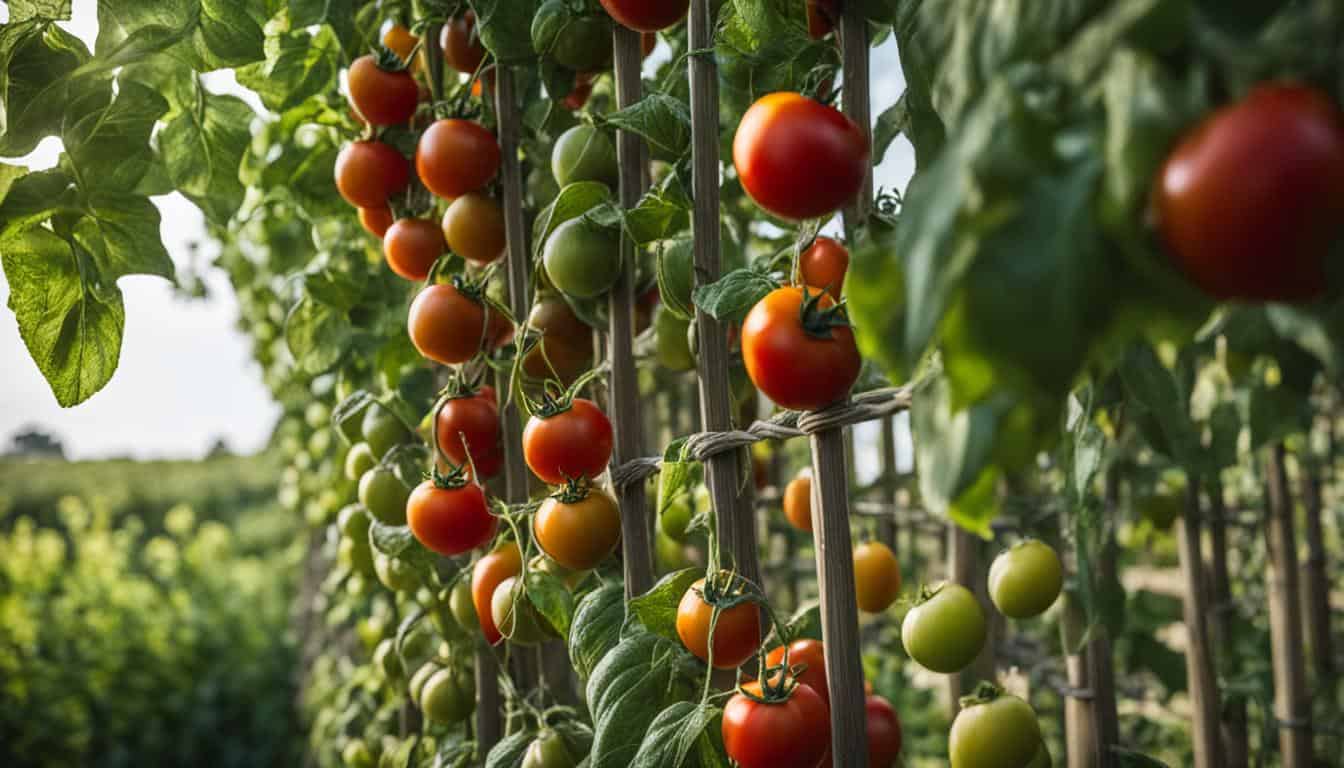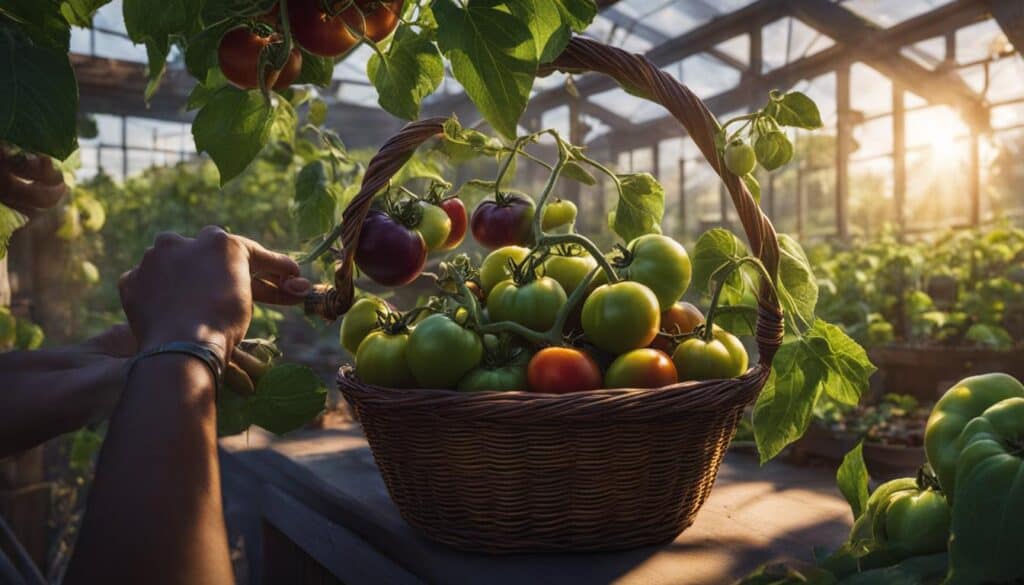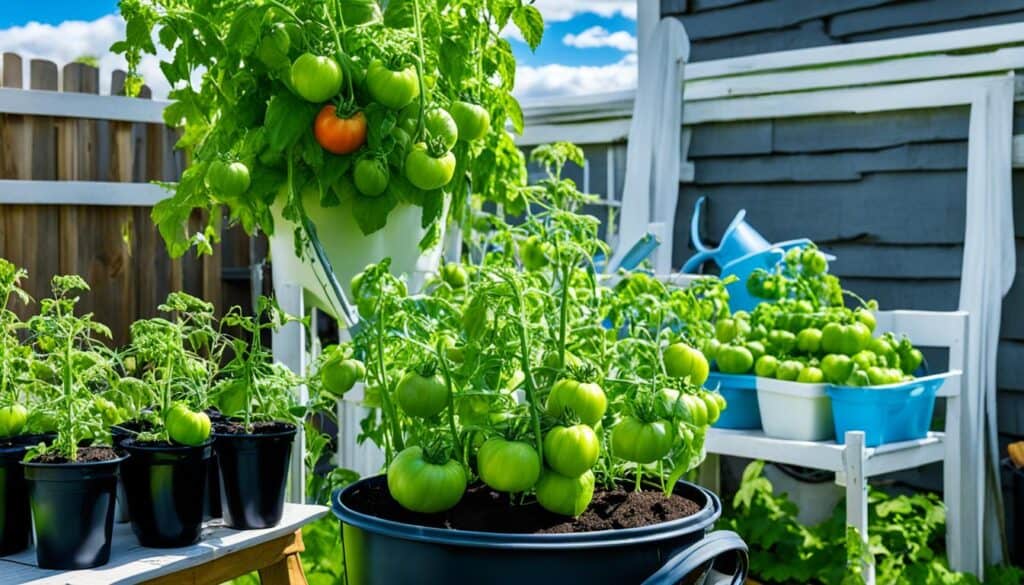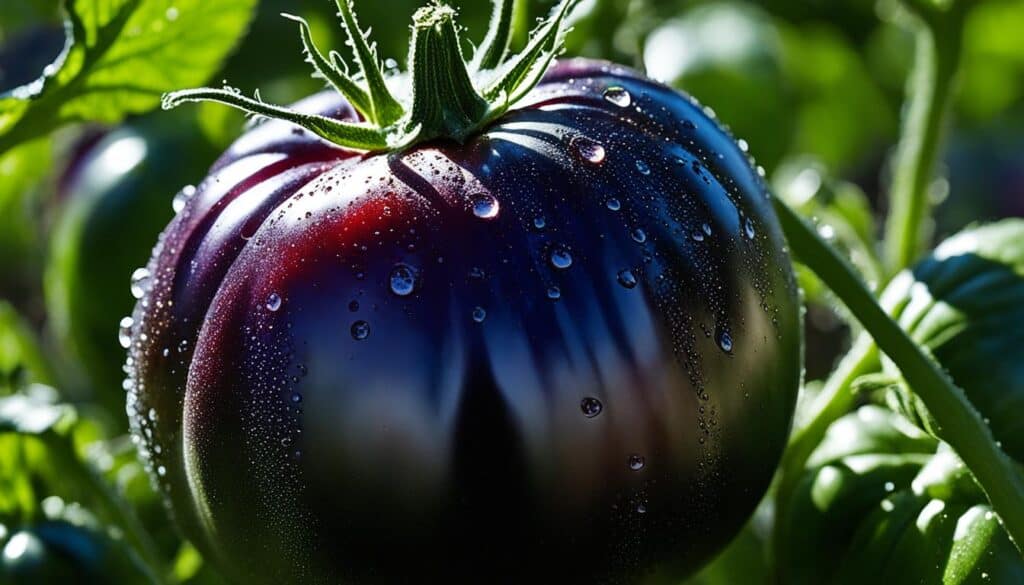Yes, you read that right. In addition to the classic red and yellow varieties, there are unique black tomatoes that are making waves in the gardening world. These heirloom tomatoes, like the popular Black Krim variety, are not only visually stunning but also bursting with intense flavor.
Key Takeaways:
- Black tomatoes, including the Black Krim variety, are a unique and visually striking addition to your garden.
- These heirloom tomatoes are known for their intense flavor, often described as slightly salty with sweet and acidic notes.
- Black tomatoes are named after the Crimean peninsula, where they originated.
- They require specific growing conditions and care, but with the right techniques, you can enjoy a bountiful harvest of homegrown black tomatoes.
- Experimenting with different methods and techniques can help you find the best approach for growing these unique tomato varieties.
Characteristics of Black Krim Tomatoes
Black Krim tomatoes, scientifically known as Solanum lycopersicum ‘Black Krim,’ are an heirloom variety that belongs to the Solanaceae family. These annual vegetables can grow up to 4-6 feet tall, with a spread of 3-4 feet. The distinctive feature of Black Krim tomatoes is their dark color range, ranging from deep maroon to almost black, making them a unique addition to any garden.
Black Krim tomatoes thrive in full sun and prefer well-drained, loamy soil with an acidic pH level. Their blooming season occurs in the summer months, and they are hardy in USDA hardiness zones 2-11. However, it’s essential to be cautious while handling Black Krim tomato plants as all parts, except for the fruit, are toxic to both humans and pets.
| Characteristic | Details |
|---|---|
| Botanical Name | Solanum lycopersicum ‘Black Krim’ |
| Family | Solanaceae |
| Plant Type | Annual Vegetable |
| Height | 4-6 feet |
| Spread | 3-4 feet |
| Color Range | Dark maroon to almost black |
| Preferred Soil | Well-drained, loamy with an acidic pH |
| Blooming Season | Summer |
| Hardiness Zones | 2-11 |
| Toxicity | All parts except for the fruit are toxic to humans and pets |
I can’t help but marvel at the striking color range of Black Krim tomatoes. From its deep maroon hues to almost black shades, they truly add a touch of elegance to any tomato collection. Their unique appearance makes them an excellent choice for those who want to experiment with different colored heirloom tomatoes.
Growing Conditions for Black Krim Tomatoes
When cultivating Black Krim tomatoes, it is crucial to provide them with the right growing conditions to ensure optimal growth and bountiful harvests. These unique tomato varieties are highly sensitive to cold temperatures, making it essential to wait until the danger of late spring frost has passed before planting them. Additionally, it’s important to pay attention to sunlight, drainage, and the previous planting history of the soil due to their specific requirements.
Black Krim tomatoes thrive in full sunlight and require ample heat exposure to develop their characteristic deep purple to black color. Select a location in your garden that receives at least 6 to 8 hours of direct sunlight per day. This abundant sunlight not only aids in color development but also contributes to overall plant vigor and fruit production.
Furthermore, well-drained soil is crucial for Black Krim tomatoes to avoid waterlogging, which can lead to root rot and other fungal diseases. Choose a location with excellent drainage, or consider amending the soil with organic matter to improve drainage if necessary. Remember that waterlogged soil can be detrimental to the growth and health of your plants and significantly impact your harvest.
It’s important to note that Black Krim tomatoes belong to the nightshade family, which includes vegetables like potatoes, eggplants, and peppers. These plants are susceptible to similar pests and diseases, so it’s advisable to avoid planting tomatoes in soil where other nightshade family members were grown the previous year. This practice helps minimize the risk of pest and disease carryover and ensures the health and productivity of your Black Krim tomato plants.
In summary, the key growing conditions for Black Krim tomatoes include:
- Planting after late spring frost and when the soil reaches 60 degrees Fahrenheit
- Full sunlight exposure for at least 6 to 8 hours a day
- Well-drained soil with good drainage to prevent waterlogging
- Avoiding planting in soil where nightshade family vegetables were grown in the previous year
By providing the ideal growing conditions, you can ensure the healthy development of your Black Krim tomato plants and enjoy a plentiful harvest of these unique and delicious tomatoes.
| Growing Conditions | Requirements |
|---|---|
| Cold Sensitivity | Plant after late spring frost and when soil temperature is at least 60°F |
| Sunlight | Full sun exposure for 6 to 8 hours a day |
| Drainage | Well-drained soil with good drainage |
| Nightshade Family | Avoid planting where nightshade family vegetables were grown the previous year |
Planting and Support for Black Krim Tomatoes
When it comes to growing Black Krim tomatoes, it’s important to understand their indeterminate nature. These tomatoes are known for their continuous growth and fruit production until the frost kills them. To ensure optimal growth and easy access for picking, proper spacing is crucial.
I recommend planting Black Krim tomatoes with a spacing of 3 to 5 feet between each plant. This spacing allows for adequate air circulation and prevents overcrowding. Here’s a useful table to summarize the recommended spacing:
| Spacing | Number of Plants |
|---|---|
| 3 feet | 5 plants |
| 4 feet | 4 plants |
| 5 feet | 3 plants |
Depending on the size of your Black Krim tomato seedlings, you can choose between two planting methods: the deep hole method or the trench method. The deep hole method involves digging a hole deep enough to cover the stem of the seedling, leaving only a few leaves above the ground. The trench method, on the other hand, involves digging a trench and laying the seedling sideways, burying most of the stem except for the top leaves. Both methods promote strong root development and help establish healthy plants.
As the Black Krim tomatoes grow tall and produce heavy fruit, it’s essential to provide them with sturdy support. I recommend using tomato cages or stakes to prevent the plants from bending or breaking under their weight. This support helps maintain proper spacing and allows for better air circulation, reducing the risk of diseases. Here’s an image illustrating a well-supported Black Krim tomato plant:
“Proper spacing and support are key factors in successfully growing Black Krim tomatoes. By providing adequate space and sturdy support, you can enjoy a bountiful harvest of these unique and flavorful tomatoes.”
Soil and Watering Needs for Black Krim Tomatoes
When it comes to growing Black Krim tomatoes, the right soil type and proper watering techniques are crucial for optimal growth and fruit development. Here’s what you need to know:
Soil Type
Black Krim tomatoes thrive in loamy, well-drained soil. Loamy soil has a balanced mixture of sand, silt, and clay, allowing for good water retention while still providing adequate drainage. This type of soil allows the roots to access water and nutrients efficiently, promoting healthy growth and preventing problems like root rot.
pH Levels
For the best results, ensure that the pH of the soil for Black Krim tomatoes falls within the slightly acidic range of 6.0 to 6.8. You can easily test the pH of your soil using a soil testing kit available at most garden centers. Adjust the pH if necessary by adding amendments like sulfur to lower the pH or lime to raise it.
Watering
Proper watering is essential for Black Krim tomatoes, especially during hot summer weather. It’s important to water deeply and regularly, ensuring that the soil remains consistently moist but not waterlogged. Overwatering can lead to root diseases and nutrient leaching. To help retain moisture, consider adding a layer of organic mulch around the plants, which also helps to suppress weeds.
Tip: Avoid overhead watering, as wet foliage can promote the spread of diseases like blight. Instead, water at the base of the plants, aiming for the soil around the roots.
Diseases
Black Krim tomatoes are susceptible to various diseases, including fungal infections like blight. To minimize the risk of disease, it’s important to follow proper watering practices and avoid splashing water onto the leaves. Additionally, ensuring good air circulation around the plants can help prevent the development and spread of diseases.
Providing a general slow-release organic fertilizer specifically formulated for vegetables, high in potassium and calcium, can help promote strong and healthy plants. These nutrients can also help prevent common nutrient deficiencies that may lead to disease susceptibility.
Ideal Soil and Watering Conditions for Black Krim Tomatoes
| Aspect | Ideal Conditions |
|---|---|
| Soil Type | Loamy, well-drained |
| pH Level | 6.0 to 6.8 (slightly acidic) |
| Watering | Deep and regular, avoiding overhead watering |
| Diseases | Prevent by ensuring good air circulation and providing proper nutrition |
By providing Black Krim tomatoes with the right soil and moisture conditions, you’ll be well on your way to cultivating healthy plants and enjoying a bountiful harvest of these delectable and unique tomatoes.
Pollination and Harvesting of Black Krim Tomatoes
Black Krim tomatoes, like other tomato varieties, go through a pollination process to produce fruit. Understanding the pollination process and the right time to harvest can help you maximize your tomato yield. Let’s explore the pollination methods and determine the optimal harvest time for Black Krim tomatoes.
Pollination Methods
Black Krim tomatoes are predominantly self-pollinating, which means that pollen from the male reproductive organs of the same flower fertilizes the female reproductive organs within the same flower. This self-pollination ensures that the tomato plants can produce fruit without relying on external pollinators such as bees or wind.
Although Black Krim tomatoes are primarily self-pollinating, there is a slight possibility of cross-pollination if other tomato varieties are planted nearby. Cross-pollination occurs when pollen from one tomato variety is transferred to the female reproductive parts of another tomato plant, resulting in genetic mixing. While cross-pollination won’t affect the current crop, it may impact the genetic characteristics of the seeds saved for future planting.
Harvesting Black Krim Tomatoes
Knowing the right time to harvest your Black Krim tomatoes is crucial to ensure optimum flavor and texture. When determining the readiness for harvest, observe the following characteristics:
- Fruit color: Ripe Black Krim tomatoes have a dark, brown-red to black coloration. The deep hues of these tomatoes indicate their rich and intense flavor profile.
- Skin texture: Look for smooth and waxy skin on the tomatoes. This indicates that they are fully matured and ready to be picked.
- Shoulder color: It’s important to note that the area around the stem, known as the shoulder, may remain green even when the tomatoes are ripe. This is a natural characteristic of Black Krim tomatoes and doesn’t indicate their unripeness.
When harvesting Black Krim tomatoes, gently twist or cut the fruit from the stem, being careful not to damage the plant or nearby tomatoes. Once harvested, store the tomatoes at room temperature to allow them to fully ripen and develop their flavors.
Now that you know about the pollination process of Black Krim tomatoes and the signs of ripeness, you can confidently enjoy the delicious rewards of your homegrown harvest. Are you ready to savor the rich flavors of these unique tomatoes?
Growing Tomatoes in Containers
Container gardening is a great option for growing Black Krim tomatoes if you don’t have a suitable location in the ground. With the right containers and techniques, you can enjoy a bountiful harvest of these unique heirloom tomatoes, right on your patio or balcony.
When choosing a container, opt for one that has a capacity of at least 10 gallons to provide ample space for the tomato plant’s root system to grow. This will help prevent the plant from becoming root-bound and restrict its growth. Additionally, ensure that the container has proper drainage holes at the bottom to prevent water accumulation and potential root rot.
Once you have the right container, fill it with high-quality, nutrient-rich potting soil. Potting soil specifically formulated for containers provides excellent drainage and moisture retention, which is crucial for the health and growth of your tomato plant. Avoid using regular garden soil as it may not have the proper structure and drainage properties necessary for container gardening.
Tomato Cages for Container-Grown Tomatoes
Just like tomatoes grown in the ground, container-grown tomatoes also benefit from sturdy support. Tomato cages are a popular choice for providing support to the plants, ensuring they grow upright and minimizing the risk of branches breaking under the weight of the fruit.
Place the tomato cage in the container before planting the tomato seedling to avoid damaging the plant’s delicate roots later on. As the tomato plant grows, gently guide the branches through the openings of the cage, helping them grow vertically and keeping the plant well-supported.
With the right container, nutrient-rich potting soil, and tomato cages for support, you can create an ideal environment for your Black Krim tomatoes to thrive and produce delicious fruits.
Tips and Tricks for Successful Tomato Growing
When it comes to growing delicious Black Krim tomatoes, starting from seeds can give you access to a wider variety of tomato options. Whether you’re a beginner or an experienced gardener, here are some tips and tricks to ensure successful tomato growing:
Providing Optimal Conditions for Tomato Seeds
Tomato seeds are the starting point of a healthy tomato plant. To give them the best chance of thriving, it’s important to:
- Choose high-quality tomato seeds from a reputable supplier, such as Burpee or Seeds of Change.
- Begin the seed-starting process indoors about 6-8 weeks before your last average frost date.
- Plant the seeds in seed-starting trays or small pots filled with seed-starting mix.
- Place the trays or pots in a warm area (around 70-75°F) with access to natural or artificial light.
- Keep the soil consistently moist but not waterlogged.
- Provide additional light with fluorescent grow lights if natural light is limited.
Dealing with Leggy Seedlings
Leggy seedlings, with long, thin stems, can be a common challenge for tomato growers. To address this issue:
- Ensure that your seedlings are receiving enough light. If they are stretching towards the light source, they need more light.
- Up-pot your leggy seedlings into larger containers filled with well-draining potting soil.
- Gently brush your fingers or a small fan against the seedlings daily to simulate outdoor wind. This helps strengthen the stems.
Hardening off Seedlings
Before transplanting your seedlings outdoors, they need to undergo a process called hardening off. This allows them to gradually adjust to the outdoor conditions and prevent shock.
“Hardening off seedlings is crucial to help them transition from the controlled indoor environment to the sometimes harsh outdoor conditions,” says gardening expert Jane Smith. “Not providing this adjustment period can lead to stunted growth and even plant loss.”
To harden off your seedlings:
- Start the process about a week before your planned transplanting date.
- Choose a sheltered outdoor spot, such as a covered porch or a spot with dappled shade.
- Gradually expose the seedlings to longer periods of direct sunlight each day, starting with just a few hours and gradually increasing.
- Bring the seedlings indoors at night during the hardening off period.
- By the end of the week, your seedlings should be ready for transplanting into their outdoor growing location.
Remember, taking the time to properly harden off your seedlings will help them thrive in their new environment.
Must-Have Tools for Successful Tomato Growing
| Tool | Function |
|---|---|
| Garden Fork | Loosens compacted soil and improves drainage |
| Garden Gloves | Protects hands from thorns, dirt, and chemicals |
| Trowel | Allows for easy digging and transplanting |
| Pruning Shears | Ensures clean cuts when pruning tomato plants |
| Garden Twine | Provides support for growing tomatoes |
| Watering Can or Hose | Essential for watering tomato plants |
| Tomato Cages or Stakes | Supports tomato plants as they grow tall |
Having the right tools can make tomato growing easier and more enjoyable, ensuring your plants have everything they need to thrive.
With these tips and tricks in mind, you’ll be well-equipped to grow healthy and abundant Black Krim tomatoes from seeds. Happy gardening!
Common Tomato Growing Questions
As an avid tomato grower, I often receive questions about various techniques and methods for cultivating these delicious fruits. Let’s address some of the most common tomato growing FAQs and provide helpful insights to ensure your tomato plants thrive.
Do epsom salts have a significant impact on tomato growth?
Epsom salts, which contain magnesium sulfate, are often touted as a remedy for tomato plant deficiencies. While magnesium is an essential nutrient for plant growth, it’s important to note that most soils already contain adequate levels of magnesium. Therefore, while epsom salts can help address magnesium deficiencies in certain cases, they generally don’t have a significant impact on overall tomato growth.
What about the fish and eggshell method?
The fish and eggshell method involves burying a fish head and crushed eggshells in the planting hole. It is believed to provide nutrients and enhance soil health. However, there is limited scientific evidence to support this practice. While fish and eggshells do contain nutrients, the decomposition process may take longer than the tomato plant’s growing season, making the direct benefits unclear. Instead, consider adding organic matter or compost to enrich the soil with essential nutrients.
Does pruning tomato plants improve fruit quality?
Pruning tomato plants is a personal preference that can impact growth and fruit quality. By removing suckers (the leafy stem that grows between the main stem and a branch), you can help control the plant’s growth, improve air circulation, and focus the plant’s energy on fruit production. Additionally, pruning can help prevent diseases by removing excess foliage. However, pruning is not essential for all tomato varieties and may not be necessary if you provide proper support and space for the plants to grow.
Remember, tomato plants are resilient and can often adapt to different growing conditions. Feel free to experiment with different techniques, but always monitor your plants and make adjustments based on their unique needs.
Common Tomato Growing Questions
Table: Comparison of Common Tomato Growing Methods
| Technique | Benefits | Scientific Evidence |
|---|---|---|
| Epsom Salts | Potential remedy for magnesium deficiencies | Limited impact on tomato growth |
| Fish and Eggshell Method | Possible nutrient enhancement | Insufficient scientific evidence |
| Pruning | Controlled growth and improved fruit quality | Personal preference; mixed scientific support |
In conclusion, while certain tomato growing methods may have their supporters, it’s important to consider the scientific evidence and understand that tomato plants have their own resilience. Focus on providing optimal growing conditions, nutrient-rich soil, proper watering, and adequate support, and your tomato plants will reward you with healthy and delicious fruits.
Conclusion
The taste and beauty of homegrown black tomatoes, like the Black Krim variety, make the growing process truly worthwhile. By providing the right growing conditions, ensuring proper support, and giving them attentive care, you can experience the unique flavors and aesthetics of these heirloom tomato varieties right in your very own garden. Feel free to experiment with different methods and techniques to discover what works best for you, and get ready to enjoy a bountiful harvest of delicious homegrown black tomatoes.
Growing black tomatoes offers a delightful and flavorful experience. With the right combination of nurturing, support, and ideal growing conditions, you will have the opportunity to savor the remarkable taste and visual appeal of heirloom tomato varieties. Make sure to conduct experiments with various methods and techniques to find the perfect approach that suits your preferences, and be prepared to witness the abundant fruition of your efforts in the form of delectable homegrown black tomatoes.










Leave a Reply